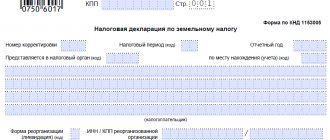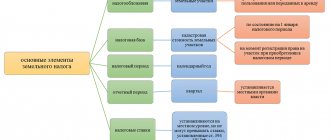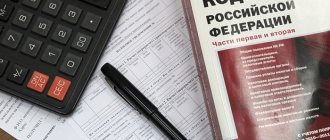Free legal consultation by phone:
8
By law, individual entrepreneurs can rent or own their own land, which will serve as their main source of income. Provided that the land plot is personal property, the individual entrepreneur pays land tax. The corresponding fees are paid to local authorities. It is the local authorities who establish, verify and control the process of paying the fee.
The procedure is carried out strictly within the framework of the Tax Code of the Russian Federation. What this amount is can only be found out from the competent authorities responsible for the procedure and reporting of this issue in the area.
Land tax
The generally accepted taxation system also includes a tax on land use. If you are the owner of a plot, you are required to pay contributions to the treasury for it. This applies to individuals and legal entities.
Land tax is regulated by three main legal acts:
- Law No. 141 of 2004;
- Law No. 382 of 2014 (everything related to changes in accrual);
- Tax Code, in particular Chapter 31.
There are two main tax rates that are adopted at the state level. They are the maximum possible for each region. Local authorities can reduce this rate, thereby reducing the tax burden in a particular region of the country.
Basic tax rates:
- 0.3% – for agricultural land in urban areas, construction of housing and communications, maintaining your own garden or vegetable garden, personal breeding of domestic animals; lands used for customs, security or defense purposes;
- 1.5% – for all other types of land plots not included in the above list.
Within one region, the land tax rate can be differentiated, that is, different between individual taxpayers. This rule is set at the discretion of the local administration.
You can find out the rate that applies in your region of residence via the Internet or by contacting the authorities directly. If you want to find information online, you need to visit the official website of the tax service of the constituent entity of the Russian Federation.
To find an accepted bet, follow these steps:
- Specify region;
- Go to the “Electronic Services” section;
- Select the “Betting Information” link;
- Indicate the tax of interest, namely land tax;
- Select a period;
- On the map that appears, mark the location of your site;
- Click on the “Search” button;
- You will see a table with a regulatory act that sets the rate in the selected region;
- On the right in the table you will see a link to the document, click on it to access the information;
- In the file that opens you will find all the necessary information.
What is the tax base?
The tax base is the cadastral value of land plots. The cadastral value is determined in accordance with the land legislation of the Russian Federation.
Organizations determine the tax base and calculate land tax independently.
Land tax for individuals is calculated by the tax service. At the same time, tax authorities receive data on cadastral value from the Federal Service for State Registration, Cadastre and Cartography - Rossreestr. The cadastral value can be found out by written request to the Rossreestr Office or the land cadastral chamber at the location of the site.
Does an individual entrepreneur pay land tax using the simplified tax system?
Article 346.11 of the Tax Code of the Russian Federation states that individual entrepreneurs using the simplified tax system are not exempt from paying land tax. An individual entrepreneur must pay land tax on the simplified tax system just like any individual. Article 388 of the Tax Code of the Russian Federation defines taxpayers of land tax, these include individuals:
- who acquired land ownership;
- having land in perpetual inheritable possession;
- received land for lifelong use.
That is, individual entrepreneurs on the simplified tax system who own land are required to pay land tax.
Question - answer on the topic
Question: IP Sidorchuk owns a plot of land for which he pays tax annually. Sidorchuk does not use the land for business activities.
Sidorchuk is a payer of the simplified tax system (income minus expenses). Can Sidorchuk take into account the amount of tax as expenses incurred and thus reduce the tax base for calculating personal income tax?
Answer: Yes, the use of land in the process of conducting business does not affect the recognition of expenses. Sidorchuk has the right to reduce the personal income tax base due to the amount of land tax.
Question: Fortuna LLC is registered in Voronezh, but has a separate division in Belgorod (not listed on a separate balance sheet). "Fortuna" uses the land for business purposes. The land is located in the Belgorod region. At what rates and in what order is land tax paid for Fortuna LLC?
Answer: Since the site is geographically located in the Belgorod region, the tax must be calculated at the rates and in the manner established in this region. Due to the fact that the Belgorod representative office does not have a separate balance sheet, payments are made by the parent company, and the recipient of the funds is the Belgorod budget.
How does an individual entrepreneur pay land tax?
Individual entrepreneurs using the simplified tax system pay land tax once a year for the previous period (year). For example, in 2021 you will pay taxes for 2021.
A tax notice is required for payment. The tax office sends this document by mail to the address where the individual entrepreneur is registered (registration address). The tax notice indicates all property taxes (land, transport). It reflects:
- owned land objects;
- cadastral value of land;
- the rate that is used in the calculation;
- the amount of land tax;
- deadline for payment of land tax (set annually by legislative acts of local authorities).
The notice is accompanied by a receipt with the details for which the tax must be paid.
If you have not received a notice, contact the tax office at your place of registration or use the “Personal Account of an Individual Entrepreneur” service on the Federal Tax Service website. Through your personal account, you can print a notice or immediately pay the tax from a card or account.
Should an individual entrepreneur submit a land declaration using the simplified tax system?
To pay land tax as an individual entrepreneur using the simplified tax system, you do not need to submit a declaration. The tax office independently calculates the tax.
Formula for calculating land tax:
ZN = KS × CH × K
Where:
ZN - land tax;
KS - cadastral value (the assessment is carried out by Rosreestr and transmits the data to the tax office);
SN - tax rate;
K - ownership coefficient (calculated if the land is owned for less than 12 months).
Rates for calculating land tax:
- 0.3%: land for agriculture, livestock breeding;
- land for housing and communal services and residential buildings;
- land for personal farming, gardening;
- lands used for customs and defense facilities;
- land plots with other purposes
But local authorities have the right to set other rates.
Federal tax benefits:
- Categories of citizens exempt from land tax: Peoples of the Far East, Siberia, the North, recognized as indigenous and small in number.
- Disabled people with groups 1 and 2.
Local Administrations have the right to establish additional benefits. All explanations on local benefits and tax rates are available on the Federal Tax Service website in the “Reference Information” section.
But to receive the benefit, you need to submit an application (KND form 1150063) to the tax office - without your application, the Federal Tax Service will not take it into account.
What are the entries in budget accounting?
Every year, funds are allocated from budgets of all levels for the payment of land tax by budgetary organizations.
How to reflect the accrual and payment of land tax by budgetary organizations is indicated in the Instructions for Budget Accounting.
Depending on which taxation system the enterprise uses, accounting for accrual and payment of land tax will occur differently.
| Tax system | Land tax accounting |
| OSN | Land tax is included in expenses when taxing profits. This is stated in paragraph 1.1 of Art. 264 Tax Code of the Russian Federation |
| simplified tax system | If an enterprise applies the simplified tax system “Income”, then the paid land tax does not in any way affect the size of the tax base for the single tax. If an enterprise applies the “STS “Income minus expenses”, then the paid land tax should be included in the expenses of the enterprise, which reduce the tax base for the single tax. This is stated in paragraph 1. 22 of Art. 346. 16 Tax Code of the Russian Federation |
| UTII | In Art. 346. 29 of the Tax Code of the Russian Federation states that paid land tax is not taken into account when calculating the tax base for “imputed” tax |
| Combination of UTII and OSN | If an enterprise uses both SST and UTII in its activities, and uses a land plot for both types of activities, then the amount of accrued land tax must be divided in proportion to the profit from each type of activity in the total profit of the company. This is due to the fact that with OSN the land tax is taken into account, but with UTII it is not. |
Land tax
According to the Instructions for Budget Accounting, land tax accounting in budgetary organizations depends on:
- use of land in budgetary activities
| Debit | Credit | |
| Land tax accrued | 1 401 012 90 “Other expenses” | 1 303 057 30 “Increase in accounts payable for other payments to the budget” |
| Land tax paid to the budget | 1 303 058 30 “Reduction of other debt on other payments to the budget” | 1 304 052 90 “Settlements for payments from the budget with bodies organizing the execution of budgets for other expenses” |
- and activities of the organization that generate income
| Debit | Credit | |
| Land tax accrued | 2 106 043 40 “Increase in the cost of manufacturing materials, finished products (works, services)” | 2 303 057 30 “Increase in accounts payable for other payments to the budget” |
| Land tax transferred to the budget | 2 303 058 30 “Reduction of accounts payable for other payments to the budget” | 2 201 016 10 “Disposal of institution funds from bank accounts” |
| Simultaneous reflection on the off-balance sheet account according to KOSGU 290 “Other expenses” | 18 “Retirement of funds from bank accounts of the institution” |
When calculating land tax under the simplified tax system, the transactions are exactly the same as in other taxation systems.
Regardless of the taxation system, the entries for the calculation and payment of land tax to the budget of the subject of the federation will be as follows:
The calculation of land tax and its reflection on one of the cost accounts depends on the intended purpose of the site.
To account for land tax, subaccount 9 “Land tax” is opened in account 68 “Calculations for taxes and fees”.
Land tax must be calculated and paid from the moment of registration of land rights. After registration, the land plot is accepted on the balance sheet of the enterprise in account 01 “Fixed assets” under the subaccount “Land plot”.
A plot of land is accounted for at its original cost. To calculate the initial amount of land tax, the cadastral value of the plot at the time of registration of real rights to it is taken.
Depreciation is not charged on land, so the tax can be reduced only if the cadastral value decreases.
For tax accounting purposes, the amount of accrued land tax is credited to account 91 “Other income and expenses” to subaccount 2 “other expenses”.
Thus, if the land plot is not used for the main activity, then the entries for the calculation and payment of land tax will be as follows:
Advance payment calculation
The Tax Code of the Russian Federation states that all taxpayers must make advance payments for land tax.
But, if the authorities of the constituent entities of the federation have not established such an obligation at the legislative level of the subject, then taxpayers should not accrue and pay advance payments.
Budgetary organizations are taxpayers of land tax, and charge and pay land tax on a general basis.
Budgetary organizations must pay land tax and advance payments from their own funds that business activities bring them.
If they do not conduct such activities, then they need to write a letter to the territorial department of the Federal Tax Service to grant them a deferment in paying this tax.
The calculation and payment of advance payments occurs in the same way as the main tax. The accounting entries are made exactly the same.
How to calculate the amount for paying land tax, read the article: calculation of land tax.
What benefits are provided to combat veterans?
For tax purposes, advance payments are taken into account in the same way as annual taxes. Such records are kept if the land plot is used for the main activity.
The basis for the calculation and payment of the advance payment, as well as the main tax, is an accounting certificate.
All accrued and paid advance payments are included in other expenses from ordinary or operating activities.
The management of the company decides how to account for advance payments. This decision must be reflected in the company's accounting policies.
The company chooses the list of indirect and direct expenses independently. They independently determine which expenses include land tax.
Such records are kept if the site is not used for the main activity.
Fine and penalty
Often, after a desk or field audit, tax authorities impose fines and penalties on taxes on taxpayers. Land tax is no exception.
If tax authorities have imposed fines and penalties, then the following entries should be made in accounting:
Even if the company is going to defend the illegality of accruing penalties and fines, it is still necessary to make an entry for the accrual of these amounts.
In 1C, transactions for calculating land tax are generated automatically.
If the company wins the case, and the accrual of fines and penalties is declared unlawful by the court, then based on the court decision, a “reversal” entry will be made.
All tax sanctions, including land tax, are not taken into account in tax accounting.
That is, when calculating the tax base for income tax, penalties are not included in the expenses that reduce this base.
The same applies to “simplified” people who use “income minus expenses”. Sanctions do not reduce the tax base for the single tax on the simplified tax system. The same state of affairs is with the “imputed” people.
Land tax rates
Tax rate
cannot exceed
0.3%
of the cadastral value of the plots:
- occupied by housing stock and utility infrastructure facilities and acquired for housing construction, except for plots used in business activities (the exception is valid from the tax period of 2021);
- purchased for personal farming, gardening, vegetable gardening. Starting from the 2021 tax period, the rate applies to plots of this group if they are not used in business activities;
- from the tax period of 2021 - general purpose land plots intended for citizens to carry out gardening and vegetable gardening or intended for the placement of other public property.
The tax rate for other areas should not exceed 1,5%
from the cadastral value.
How is land tax calculated for individual entrepreneurs using the simplified tax system?
There is no need to fill out a lot of paperwork, nor do you need to submit reports or make calculations. There are several points to consider.
According to the simplified system, land is not included in expenses. Costs associated with completing a purchase or sale transaction may be partially or fully refunded.
When calculating the simplified tax, special attention is paid to the following expenses:
- funds spent on paperwork and notarization;
- money that went to pay for the services of institutions producing cadastral registration forms;
- purchase of documents that must confirm ownership of the land plot;
- various taxes and fees that were paid when purchasing the site.
These expenses, subject to refund under the simplified system, are legally enshrined and specified in the Tax Code of the Russian Federation.
The following types of real estate owned by an individual entrepreneur should be subject to land tax:
- plots owned by a businessman;
- land to which a person has the right of lifelong ownership and can freely transfer it by inheritance;
- plots that are used on an indefinite basis.
What are the features of land tax? According to the established rules, the land tax of individual entrepreneurs on the simplified tax system does not provide for the submission of a land declaration. Since the beginning of 2021, some amendments have been made to the tax legislation regarding this point.
Previously, the individual entrepreneur himself had to fill out and submit the document to the inspectorate.
Now, service employees independently carry out calculations, and then send a notification with the amount to the individual entrepreneur’s address.
But such changes apply only to individuals, but legal entities must still fill out a declaration.
The letter must be sent no later than 2 weeks before the payment deadline. If this does not happen, then the individual entrepreneur is obliged to contact the tax office at his place of residence.
You can call and find out the amount of tax that needs to be paid. Before paying, you need to calculate and reconcile all expenses in order to reduce the total amount using the simplified system.
Each check or receipt used to pay tax must be recorded in the accounting book. You also need to paste financial documents there to confirm your right to a land tax benefit.
To make the correct calculation, you must consult an inspector or accountant who will check the blank documentation and calculate the amount to be paid.
Tax payment procedure for individual entrepreneurs and organizations
Legal entities using the simplified tax system and individual entrepreneurs who use the simplified tax system pay tax in different ways. The reporting procedure for organizations and individual entrepreneurs using the simplified regime is also different.
Let's start with entrepreneurs. If you have registered an individual entrepreneur and own land, then you do not need to worry about calculating taxes and submitting documents. According to the changes that came into force on 01/01/15, entrepreneurs pay tax on the basis of a notification. The simplified procedure provides for the following conditions:
- You do not need to calculate the tax amount yourself. The fiscal service authority will send you a notification by mail, which will provide a full calculation of the payment amount;
- Along with the notification, a receipt is sent by mail, which contains all the necessary details for payment. All you need is to go to the nearest bank branch along with the receipt to transfer funds;
- For individual entrepreneurs, the obligation to file a tax return has been canceled, that is, there is no extra reason to visit the Federal Tax Service.
Individual entrepreneurs pay land taxes in the current year for the previous year (until December 31). The law stipulates that you must receive the notification no later than November 1 of the year (for 2021 - before 11/01/17).
The situation is a little more complicated with legal entities - “simplified”. They have a complete procedure for calculating tax, paying it and submitting reports.
Let's start with the documents: before February 1 of the next year, the “simplified” organization submits a declaration in which it indicates the full calculation of the tax in accordance with the established norm. You can submit your declaration in the way that is most convenient for you:
- Personal visit to the Federal Tax Service (receiving a form and filling out the form on the spot);
- Russian postal services (sending a letter with a notification and a list of attachments);
- Transfer of papers through a representative (you must first contact a notary to draw up a power of attorney);
- Using the electronic resource of the Federal Tax Service (the website of the fiscal service offers users the service of filing reports via the Internet).
Expert opinion
Popov Igor Severinovich
Legal consultant with 8 years of experience. Specialization: civil law. More than 3 years of experience in document examination.
By filing your return on time, ensure that your tax is paid on time. The law regulates the advance payment system for land taxes.
Payments are made quarterly, their amount is determined as ¼ of the annual one. The payment deadline for each amount is until the end of the month following the quarter.
Full payment of land tax must be made no later than October 1 (until 10/01/17 for 2016).
The accountant of Fontan LLC calculated the amount of land tax for 2016 in the amount of 2,104 rubles. Quarterly payments were:
RUB 2,104 / 4 sq. = 526 rub.
When submitting a declaration at the end of the year, the Fontana accountant indicated the annual amount of 2,205 rubles. (including recalculation). The final calculation of the land tax was made by Fountain on January 10, 2017. The last payment amount was calculated as follows:
RUB 2,205 – (526 rub. * 4 sq.) = 101 rub.
Calculation formula
Note!
Since 2015, individuals, including entrepreneurs, no longer have to calculate land tax on their own. This responsibility is assigned to the Federal Tax Service. Payment is made according to the tax notice.
Land tax is calculated using the following formula:
Land tax = Kst x D x St x Kv
,
Kst
– cadastral value of the land plot (it can be found on the official website of Rosreestr or using a cadastral map).
D
– the size of the share in the right to a land plot.
St
– tax rate (you can find out the tax rate in your region on this page).
Kv
– coefficient of ownership of a land plot (applies only in case of ownership of a land plot for less than a full year).
Nuances
The calculation and payment of land tax, like any other tax, has its own nuances. To avoid getting into trouble, you need to know a few important points.
If a land plot is provided for a fee for temporary use under a lease agreement?
The use of land in our country is paid. Owners pay land tax, and tenants pay rent according to the agreement.
Land leased under a lease agreement is not subject to land tax.
This is clearly stated in the Tax Code of the Russian Federation. The owner of the land must pay taxes on the plot of land.
The tenant, by paying a fee under the agreement, compensates the owner for all costs associated with the use of the land by the tenant, including land tax.
For an enterprise that has provided a plot of land for rent, the accrual of land tax will be reflected in account 91 of subaccount 2, since renting land is not the main activity of the enterprise.
The wiring will be as follows:
If the provision of land for rent is the main activity of the enterprise, then the accrual of land tax is taken into account on one of the cost accounts, usually on account 25 or 26.
Which entry reflects the transfer of land tax to the budget?
Every quarter, enterprises transfer advance payments to the budget, and at the end of the year - the main tax. During the year, the amount of accrued tax is accumulated in account 68 in subaccount 9 “Land tax”.
The tax is transferred from the company's current account. Payments must be made every quarter so that the amount of non-payment does not accumulate on account 68-9.
The transfer of land tax to the budget is reflected by the following entry:
Land tax benefits
Some payers may be able to take advantage of federal and local incentives. If the tax authority has information about the payer's right to a benefit, it will be taken into account when calculating the tax. But if the taxpayer noticed upon receiving the notification that the benefit was not taken into account, he needs to submit an application to the Federal Tax Service using the form from the order dated November 14, 2017 No. ММВ-7-21 / [email protected] The application is provided only once - then the benefit applies automatically.
Federal benefits
The indigenous peoples of the North, Siberia and the Far East, as well as their communities, do not pay land tax on plots that are used to preserve their traditional way of life.
When calculating the tax for certain categories of payers, the base is reduced by the cost of 6 acres of land area. The benefit is valid for disabled people of groups 1 and 2, Heroes of the USSR and the Russian Federation, WWII veterans, pensioners, parents of large families, and Chernobyl survivors. The full list of preferential categories is in paragraph 5 of Art. 391 Tax Code of the Russian Federation.
If there are several plots, the tax exemption benefit for 6 acres is valid only for one of them. The payer himself can choose which one. To do this, he needs to submit to any Federal Tax Service a notification about the elective land plot in the form approved by Order of the Federal Tax Service dated March 26, 2018 N MMV-7-21/ [email protected]
Local benefits
Representative bodies of municipalities may, by their acts, introduce additional benefits for certain categories of citizens. They allow you not only to reduce the amount of land tax required to pay, but also not to pay it at all.
To obtain information about established land tax benefits, you can use a special service on the tax service website.
Calculating taxes
Not all beginning entrepreneurs know whether they submit a land tax return. Currently, individual entrepreneurs are exempt from drawing up and filing a declaration.
Previously, it was necessary to submit reports to the tax service, but now individual notifications with the amount are sent to the entrepreneur’s address.
Such notifications are sent before October 31 of the year following the reporting year. That is, for taxes for 2021, the payment letter will arrive in October 2021. Payment deadlines end on December 1st after receiving a receipt from the tax office.
Therefore, if a payment receipt has not appeared in your mailbox by October 15, we recommend visiting the tax authority to clarify the circumstances and receive a notification.
Depending on what dates in the month you purchased the plot, that month may or may not be included in the payment.
A full month will be taken into account if:
- The plot is registered from the 1st to the 15th of the month (for the buyer);
- The plot was sold from the 16th to the 31st (for the seller).
The month of purchase/sale will not be taken into account for tax purposes if:
- The plot was purchased from the 16th to the 31st (for the buyer);
- The plot was sold from the 1st to the 15th (for the seller).
The land tax payment process includes the following steps:
- The tax authority draws up a notice of payment with a receipt;
- The document is sent to the individual entrepreneur’s registration address;
- The entrepreneur pays the tax using the specified details at any bank that provides such a service.
Who can work on the simplified tax system and who benefits from it
Simplification, despite all its attractiveness, is not suitable for every taxpayer. And it is wrong to recommend that every organization switch to this mode. When choosing the optimal tax system, many factors matter:
- Kind of activity.
Although the simplification applies to most types of activities, some taxpayers cannot use it. These, for example, include banks, insurers, companies with branches and some other organizations listed in paragraph 3 of Art. 346.13 Tax Code of the Russian Federation. - Amount of annual income.
LLCs whose annual income is more than 150 million rubles cannot work under the simplified tax system. If an organization exceeds this limit, it is transferred to OSNO and pays taxes in accordance with this taxation regime. - Amount of workers.
The maximum number of employees that an LLC can have under the simplified tax system is 100 people. In case of excess, you will have to switch to the general taxation regime. - Cost of fixed assets.
Restrictions on simplification also affect the size of the organization’s fixed assets – no more than 150 million rubles. - Circle of main counterparties.
The use of the simplified tax system will be unprofitable if the main partners of the company are on OSNO, since they need to issue invoices with VAT. Accordingly, the tax will either have to be included in the price of the goods, thereby increasing it, or paid from one’s own funds at a loss. In addition, an organization will not be able to reimburse the VAT paid to the budget using a simplified procedure.
Note
: even if the company does not fall under any of the above restrictions, the tax burden on the simplified tax system must be compared with other taxation systems. It may turn out that using UTII or OSNO will be more profitable than working with a simplified version.
When choosing a simplified tax system, special attention should be paid to its objects, on which the tax rate directly depends. The simplified taxation system has two taxation objects:
- Income.
The tax is calculated based on the amount of income received. The rate at this facility is 6%, while in some regions it can be reduced to 1%. When calculating tax, expenses are not taken into account, with the exception of insurance premiums for employees. This option will be most optimal for organizations with minor expenses - no more than 65% of the amount of income received. - Income minus expenses.
The rate in this case is 15%, but can also be reduced by decision of regional authorities to 5%. The tax is calculated on the difference between income received and expenses incurred. This regime will be beneficial to organizations whose costs are quite significant and exceed on average 65% of the amount of income, for example, for wholesale trade and production.
And now more about what taxes an LLC pays under the simplified tax system in 2020.
Calculating the base
If you apply the “income” scheme, then based on the completed KUDiR from the beginning of the year you need to summarize (taking into account the provisions of Articles 250, 254, 284 and 224 of the Tax Code of the Russian Federation):
- income from sales;
- other non-operating income.
From the resulting amount you can subtract the following value:
- actual contributions made to the Social Insurance Fund, Compulsory Medical Insurance Fund and Pension Fund;
- sick leave benefits paid to employees;
- contributions under voluntary insurance contracts for employees;
In this case, the amount of EH payable after the calculations made cannot decrease by more than half.
Enterprises and individual entrepreneurs paying the unified tax according to the “income-expenses” scheme, from the beginning of the period, sum up their income according to KUDiR, and then subtract from them the expenses determined in accordance with the provisions of Article 346.16 of the Tax Code of the Russian Federation. Remember that for the “income-expenses” scheme there is an approved procedure for confirming transactions (Article 346.17 of the Tax Code of the Russian Federation), which must be strictly adhered to. If you are not sure of the integrity of your counterparties, think several times before choosing “income-expenses” as the basis for the simplified tax system.
Also remember that there are some special conditions when defining a base:
- Individual entrepreneurs working without hiring employees have the right to reduce the base under the simplified tax system “income” by the entire amount of fixed contributions from the Pension Fund of the Russian Federation, the Compulsory Medical Insurance Fund and the Social Insurance Fund. At the same time, additional contributions (1% of the amount exceeding the minimum annual income) cannot be taken into account in the UN base.
- Entrepreneurs using the income-expenses scheme can carry forward losses incurred in the current year to periods in the future (within 10 years). At the same time, in the declaration and when making accounting entries for calculating the single tax, the amount of the loss must be shown and documents confirming it are reflected. Otherwise, it will be impossible to exercise the right to reduce the future simplified tax base. This rule is valid even if you have just started your business and only have expenses for now.
LLC taxes simplified
Payments of an organization under the simplified taxation system can be divided into three groups:
- Single tax in accordance with the selected object (“Income” or “Income minus expenses”).
- Additional taxes.
- Deductions for employees.
Simplified tax
Organizations using the simplified tax system are required to transfer only one tax to the budget - a single one. It is paid as follows:
- Advance payment based on the results of the reporting period (1st quarter, half year, 9 months).
- Tax for the year.
The procedure for calculating advances and annual payments depends on the selected object of taxation under the simplified tax system. The deadline for payment of simplified advances is no later than the 25th day of the month following the previous quarter. The tax is paid once a year - until March 31.
Additional taxes
Organizations using the simplified tax system in 2021 are exempt from paying VAT, income tax and property tax. But there are situations in which payment of these payments is required.
What do you need to know about the single tax?
Entrepreneurs who apply the “simplified tax” pay one instead of three main taxes (profit, property and value added):
- or 6% of total income for 12 months;
- or 15% of the difference between income and expenses, but not less than 1% of total income.
The percentage charged under the “income” taxation scheme is unchanged. But for legal entities and individual entrepreneurs who have determined the “income-expenses” scheme as the basis, regional laws may establish a reduced tariff.
Also from 01/01/15. for individual entrepreneurs who carry out business activities in the following areas:
- education,
- the science,
- production,
For two years in a row, a zero (0%) single tax tariff is established if the individual entrepreneur meets the following requirements:
- 70% of income from economic activities relates to income in one of the areas indicated above;
- The individual entrepreneur complies with the requirements of regional law in terms of the average number of employees and the amount of total income received.
For tax purposes, all incoming and expended funds from the business or other activities of a legal entity or individual entrepreneur must be reflected in the KUDiR.
Next, on the basis of the formed KUDiR, from the beginning of the year until the end of the corresponding payment period, either the amount of income or the difference between income and expenses is calculated.
Advance periods for the Unified Tax Code on the simplified tax system are 3,6 and 9 months, while the tax period is considered to be one calendar year. Accordingly, the single tax must be calculated and paid four times a year - at the end of each quarter and within 3 months after the end of the tax period. The transfer of tax for the entire period is carried out simultaneously with the submission of a tax return, which reflects the amounts of payments already made and the remaining amount of debt.
Remember that from 01/01/2013 all entrepreneurs on the simplified tax system are required to maintain not only KUDiR, but also organize full-fledged accounting, as well as generate accounting and tax reporting. Accordingly, your task, as a payer, is not only to calculate and transfer tax to the budget, but also to correctly calculate and write it off using accounting entries.
General provisions on land tax under the simplified tax system
Based on Art. 388 of the Tax Code of the Russian Federation, the obligation to pay land tax arises for any person (legal and individual) if he owns a land plot (or in perpetual use or lifelong possession).
In order to classify paid land tax as expenses when calculating income tax, personal income tax or under the simplified tax system with the object of taxation “income minus expenses”, it is important that the land plot is used for taxable commercial activity.
ATTENTION! Land tax is paid to the Federal Tax Service at the location of the land plot (Letter of the Ministry of Finance dated November 29, 2017 N 03-05-05-02/79165).
When the obligation to pay land tax arises and which areas are taxable, find out in the article “Object of taxation of land tax”.
New bans on tax exemptions
New paragraph 2 of Art. 395 of the Tax Code of the Russian Federation, which was introduced by Law No. 353-FZ of November 27, 2017, regulates the situation when, when dividing or merging land plots, tax exemption is not applicable to the resulting objects. This applies only to the following categories of payers:
- residents of a special economic zone (there will be no tax exemption for the first 5 years);
- shipbuilding enterprises are residents of the industrial and production SEZ (there will be no tax exemption for the first 10 years);
- participants of the free economic zone (there will be no tax exemption for the first 3 years).
Reflection of land tax in accounting
In accounting, operations for the calculation and payment of land tax are reflected using the following entries:
- Dt 08, 20, 23, 25, 26, 44 or 91 Kt 68 (corresponding subaccount for land tax accounting) - tax accrual;
- Dt 68 (corresponding subaccount) Kt 51 - tax payment.
We talked in more detail about the transactions for calculating land tax in this material.
The amount of paid land tax under the simplified tax system can be included in the expenses of “simplified” residents, and this will reduce the tax base, and accordingly, the amount of the single tax (subclause 22, paragraph 1, article 346.16 of the Tax Code of the Russian Federation). However, this is only possible for “simplified” ”, who have chosen as the object of taxation income reduced by expenses.
The article “Accounting for expenses under the simplified tax system with the object “income minus expenses”” will help you understand the accounting of expenses for “simplified” people .
This might also be useful:
Is the information useful? Tell your friends and colleagues
By clicking on the “Submit” button you confirm that your comment does not contain personal data in any combination.
Questions and answers in the comments are provided by site users and are not in the nature of legal advice. If you need legal advice, we recommend that you obtain it by calling the numbers listed above or using this form
The simplified taxation system was created specifically to make life easier for entrepreneurs, and not complicate it. In fact, often, everything happens exactly the opposite: a payer who has recently switched to the simplified tax system is lost and does not understand either how to calculate the single tax or how to reflect it in accounting. The result is a lot of errors, and the Internet is full of messages “help me calculate the simplified tax system.”
We have collected all the most common mistakes when calculating a single tax, read the questions and advice from regulars, and prepared a cheat sheet for you: how to correctly reflect the tax under the simplified tax system using transactions?
The procedure for calculating land tax
Land tax is calculated by multiplying the tax rate by the tax base, which is the cadastral value of the land. When calculating tax for the year, you should take the cadastral value established at the beginning of the tax period. A new procedure for calculating property taking into account its cadastral value was introduced in 2015.
If the taxpayer has challenged the cadastral value of his plot indicated in Rosreestr in court or in the cadastral commission and a positive decision has been made in the case, he has the right to recalculate the land tax for all periods up to the moment when the application for revision was submitted.
The regional government forms the tax rate (the size of which is directly dependent on the category of land) by issuing a corresponding law by the subject of the Federation. The limit value established in the Tax Code of the Russian Federation is the tax rate (in accordance with paragraph 1 of Article 394 of the Tax Code of the Russian Federation) in the amount of:
- 0.3% for agricultural land and for the maintenance of subsidiary farming, as well as for plots of housing and limited-use plots;
- 1.5% for other lands.
Taxpayers - legal entities pay land tax in advance payments (clause 2 of Article 396 of the Tax Code of the Russian Federation).
We calculate and pay taxes
You have calculated the tax base for a certain period of time. What's next?
Next, we calculate the amount of EUR to be paid to the budget (line 110 of the declaration). To do this, we multiply the base by the corresponding tax rate and subtract the amount of tax contributions already paid from the resulting value. The resulting amount is a tax or advance payment, which you need to reflect in accounting for accrual or payment in an accounting program, for example 1C.
If you have a 1C version younger than 8.3.0.31.11, you will have to enter transactions for the single tax simplified tax system manually or use semi-automatic filling. For semi-automatic filling you need:
- Go to the main page of the program;
- Enter the section “Correspondence of invoices”;
- To calculate tax, select account “99” in the drop-down list for debit, and subaccount “12” for credit “68”.
- In the “Documents” column we find the hyperlink “Operation BU and NU” and follow it. Fill in the empty fields and indicate the amount.
- We press Enter and we can see the completed operation in the log.
In the same way, the posting for the payment of EN with the correspondence of accounts “Dt 68.12 Kt.51” is carried out, and we indicate the document - “write-off from the account” on the “Bank and Cash Office” tab. By the way, in later versions of 1C, the calculation and payment of tax according to the simplified tax system are fully automated.
>Recording of land plots under “simplified”
O.E. Shpilevaya, D.V.
Deadlines and procedure for submitting reports and paying land tax
The frequency and timing of payment of land tax are established by regional laws, which are adopted by municipal authorities (clauses 1 and 2 of Article 397 of the Tax Code of the Russian Federation). And in paragraph 9 of Art. 396 of the Tax Code of the Russian Federation states that the municipal legislative body may even cancel the quarterly payment of advances for certain categories of taxpayers.
In Art. 397 of the Tax Code of the Russian Federation defines deadlines for paying taxes and submitting reports. The deadline for filing a tax return is February 1. As for the tax itself, legal entities cannot pay it before this deadline. You can find out more about the deadlines for paying land tax in your region on the official website of the Federal Tax Service.
IMPORTANT! From 2021, land tax for legal entities will be calculated by tax authorities based on the information they have received from the Roskadastre service. If a legal entity has a benefit, it is obliged to notify the Federal Tax Service about this. If a company has a plot of land, but has not received a notification about the tax, from 01/01/2021 it is obliged to notify the Federal Tax Service about the available land. If the message is not sent on time, tax authorities will issue a fine of 20% of the tax amount. For details, see the material “Organizations will have to report transport and land plots to the tax authorities.”
Starting from 2021, individual taxpayers must pay the local budget by December 1 of the year following the reporting year (Law No. 320-FZ dated November 23, 2015 “On Amendments to the Tax Code of the Russian Federation”).
IMPORTANT! From 01/01/2021, a single deadline for payment of land tax and advances on it for legal entities is established throughout the Russian Federation - March 1 of the year following the reporting year for payment of the annual tax, and the last day of the month following the reporting quarter for the transfer of advances. See here for details.
Tax notices for individual entrepreneurs
Individuals are exempt from the obligation to report to the tax office - instead, they receive tax notices with the amount of land tax to be paid already calculated by the fiscal authorities.
If the taxpayer has not received a tax notice, he must himself contact the tax authority at the location of the land plot and report the existing object of taxation. You will also need to submit title and registration documents for the land.
This obligation arose due to the introduction into Art. 23 Tax Code of the Russian Federation, clause 2.1. This means that if an individual or individual entrepreneur does not receive a tax notice about the payment of land tax by the end of 2021, then he must contact the fiscal department himself, filling out a special message about the availability of real estate.
The message form can be downloaded here.
In paragraph 2 of Art. 52 of the Tax Code of the Russian Federation states that the Federal Tax Service sends notifications with tax calculations 30 days before the deadline for paying land tax. For individuals, this deadline is December 1. That is, taxpayers can take care of submitting information to the Federal Tax Service in connection with failure to receive notifications as early as November 2021.
For failure to fulfill the obligation to independently contact the tax authority due to failure to receive a notification, a fine of 20% of the unpaid amount of tax and penalties will be charged (clause 3 of Article 129.1 of the Tax Code of the Russian Federation).









